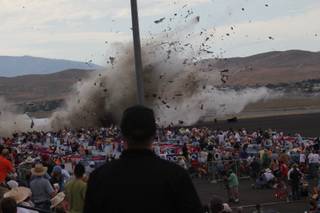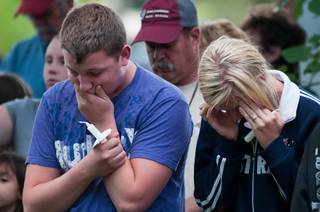
Ward Howes / AP
A P-51 Mustang airplane crashes into the edge of the grandstands at the Reno Air show on Friday, Sept. 16, 2011. The World War II-era fighter plane flown by a veteran Hollywood stunt pilot Jimmy Leeward plunged Friday into the edge of the grandstands during the popular air race creating a horrific scene strewn with smoking debris.
Monday, Aug. 27, 2012 | 9:37 a.m.
Sun archives
- Course for Reno Air Races altered after last year’s deadly crash (5-22-12)
- Despite deadly crash, officials move ahead with plans for Reno air races (1-4-12)
- Plane in Reno crash had ‘radical’ changes to compete (9-17-11)
- Reno air show crash killed 9; probe focuses on wayward part (9-17-11)
- Friends: Pilot in Reno crash was skilled airman (9-16-11)
- At least 3 killed, 56 injured when plane crashes at Reno air race (9-16-11)
A plane that crashed into spectators at an air race in Reno last year bore modifications that weakened its structure and showed evidence that it was flown beyond its limits, investigators said Monday.
The National Transportation Safety Board deemed the failure of a tail structure to be the probable cause of the crash of the souped-up World War II-era P-51 Mustang fighter that killed pilot Jimmy Leeward and 10 people on the ground at last year's National Championship Air Races in Reno and injured more than 70.
Leeward also was blamed for failing to fully document and test extensive modifications to the aircraft before the September 2011 crash.
Board member Robert Sumwalt said: "If you want to go out and fly fast and try to win, that's one thing."
"If you're modifying an aircraft without fully understanding how the modifications can affect the aerodynamics, you're playing Russian roulette," Sumwalt said.
Structural modifications of the aircraft dubbed the Galloping Ghost made it lighter and reduced drag, according to the NTSB report. But flight control modifications also made the aircraft less stable. The NTSB found that an elevator trim tab malfunction created aerodynamic instability that made Leeward's plane uncontrollable.
High-resolution photos show the skin wrinkling and a the canopy separating the plane seconds before the crash, and NTSB investigators later found loose screws in the crucial tail assembly.
At a board hearing in Washington, Chairwoman Deborah Hersman blamed the 74-year-old Leeward for "operating at the edge of the envelope" without fully reporting and testing modifications to his plane.
Leeward was "incapacitated" and probably became unconscious when gravitational forces reached 17 times normal as the propeller aircraft — flying faster than it ever had before — pitched skyward, rolled upside down and slammed nose-first into the tarmac amid rows of box seats, NTSB investigators found. The tail stabilizer fell from the plane during the steep climb.
NTSB officials say Leeward had perhaps one second to respond, but the G forces on his body far exceeded the levels of human tolerance. People can begin to experience loss of consciousness at 5G.
With races set to start Sept. 12, the five-member panel has already issued several preliminary reports and recommendations for the Federal Aviation Administration and race organizers to improve safety. Some recommendations were modified on Monday.
Hersman noted that the board is an independent investigative and recommendation body, not a regulator.
"We make recommendations. It's up to others to implement them," she said. "They've done that."
A spokesman for the air races said last week that event officials wouldn't comment on NTSB reports ahead of the board's findings on the cause of the crash. But he said event officers were improving preflight inspections.
Efforts to reach Leeward family members Monday in Ocala, Fla., weren't immediately successful.
NTSB officials say the 530 mph that Leeward reached during a qualifying race was about 40 mph faster than he had ever gone before.
His age and physical condition weren't considered significant factors in the crash, but Hersman was critical of Leeward's record-keeping and reports of the modifications that he had made. "He put that he was 59 years old on the entry form," the board chairwoman said. "He was 74."
The air race championship, entering its 49th year, is the only event of its kind in the world. It draws thousands every year to Reno Stead Airport, where it features aircraft flying at speeds of over 500 mph sometimes wingtip-to-wingtip around an oval pylon track.
The crash spawned civil liability lawsuits against the pilot's family and mechanics and the host organization.
Some critics called for ending the event, but organizers pressed forward with plans for this year's races amid promises that most NTSB safety recommendations would be implemented.
The National Air-racing Group Inc. and the Reno Air Racing Association Inc. balked at requiring pilots to wear flight suits designed to mitigate high gravitational forces. They said the expensive suits might prove too bulky for cramped cockpits and too hot during competition.
Insurance premiums jumped from $300,000 last year to $2 million this year, but the Nevada state tourism commission last month approved a $600,000 sponsorship to help the Reno Air Racing Association Inc. meet a Sept. 1 deadline for its final insurance payment.



Join the Discussion:
Check this out for a full explanation of our conversion to the LiveFyre commenting system and instructions on how to sign up for an account.
Full comments policy